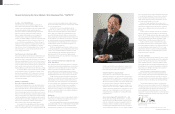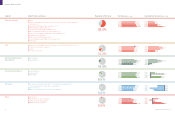Yamaha 2007 Annual Report Download - page 18
Download and view the complete annual report
Please find page 18 of the 2007 Yamaha annual report below. You can navigate through the pages in the report by either clicking on the pages listed below, or by using the keyword search tool below to find specific information within the annual report.
Magnesium parts used in mobile phones
Yamaha Annual Report 2007 3433
Within this segment, the golf products and metallic molds/components
businesses continue to achieve steady growth. The automobile interior wood
components business has been spun off and merged with Yamaha Fine
Technologies Co., Ltd. to exploit operational synergies with the metallic
molds and components business. Overall prospects for increased profit
generation by these operations going forward are good.
Business outline
This segment consists of golf products and
automobile interior wood components supplied by
Yamaha Corporation, and factory automation (FA)
equipment and metallic molds/components that are
manufactured and sold by subsidiary Yamaha Fine
Technologies Co., Ltd. (YFT). Effective April 1, 2007,
Yamaha span off the automobile interior wood
components business and merged it with YFT. The
aim of this spin-off is to sustain growth and raise
productivity by realizing synergies in marketing,
technology and manufacturing.
Performance overview
Segment sales totaled ¥32.4 billion, a 31.2% increase
in year-on-year terms. This result reflected strong
growth in sales of golf products for export markets
mainly in South Korea and a significant increase in
sales of magnesium parts and plastic parts in the
metallic molds and components business. Although
production levels of automobile interior wood
components increased due to demand created by the
introduction of new models, production yields were
lower than anticipated. As a result, operating income
slipped below target. Segment operating income rose
36.5% compared with the previous year to ¥0.8 billion.
Business strategy
Under the “YGP2010” medium-term business plan,
the segment targets for fiscal 2010 are ¥34 billion in
sales and ¥2.5 billion in operating income. Market
trends and policy initiatives in each business are
outlined below.
Golf products
In the golf products business, Yamaha’s primary tar-
get customer group is wealthy individuals in their 50s
and 60s with a taste for the genuine article. The main
sales markets are Japan, South Korea, Hong Kong
and Southeast Asia. Although the market for golf
equipment in Japan remains on a declining trend,
demand is expanding briskly in overseas markets. A
golfing boom in Korea and a doubling of Yamaha’s
sales in Hong Kong during the year both contributed
substantially to an excellent performance in fiscal
2007. Moreover, a successful advertising campaign in
Japan during the second half of calendar year 2006
boosted sales and higher brand recognition among
customers, helping Yamaha to increase market share.
Sales growth was in double digits for the second year
running. These factors resulted in a major improve-
ment in the profitability of the golf products business.
Yamaha launched a fully remodeled range of golf
clubs under the “New inpresTMX” brand during fiscal
2007. These clubs conform to the new standards
limiting the allowable coefficient of restitution for driving
clubs that are due to come into force in 2008.
Furthermore, they boost the maximum and average
distance of drive compared with previously launched
models of high coefficient of restitution. As a result, the
new range contributed to increased sales of the
business. Also popular were an order system for
custom-built clubs and made-to-order driving clubs
which are tailored to a customer’s swing using a
special analyzing system.
Yamaha expects the introduction of the new
standards to stimulate fresh replacement demand in
2007 from clubs of high coefficient of restitution to
clubs that are compliant with the new standards.
The next few years will also see the retirement of
Japan’s so-called baby boom generation. The
projected increase in the number of people that can
enjoy golf as a leisure pursuit is forecast to promote
a further increase in sales. Going forward, Yamaha
plans to strengthen its earnings base to boost the
contribution of this business to Yamaha Group
profits by conducting effective advertising
campaigns to stimulate sales growth.
Review of Operations lOthers
include stricter quality standards and delays in
improving production yields for wood fabrication
processes.
The spin-off of the automobile interior wood
components business and its integration with the
metallic molds and components business aims to
promote synergy due to mutual development of
marketing activities among existing customers and
common utilization of mold-related technologies.
Other projected benefits include reconstruction of
manufacturing processes in component
businesses and the sharing of personnel. Through
the integration process, Yamaha aims to develop
optimized mass-production processes for the
automobile interior wood components business,
while also developing more high-value-added
product lines and expanding sales network.
The company is working in cooperation with
automakers to raise production yields. The
company aims to improve profitability by focusing
resources on the execution of a number of
ongoing measures.
Metallic molds and components
The metallic molds and components business
uses an integrated production process from
development through to mold fabrication and
coating, in addition to a 3-D production process.
Yamaha supplies magnesium parts and plastic
parts for products such as household appliances,
communications equipment and mobile devices.
Demand for magnesium parts continues to
expand in particular as mobile phones become
thinner and amid pronounced growth in the market
for high-end digital single-lens reflex cameras. On
the other hand, Yamaha expects a continuation of
trends such as highly variable orders and unit price
erosion. This reflects a growing need for small-lot
production of a large product range, the shift
toward increased functionality in products and the
shorter product life cycles.
Going forward, Yamaha aims to expand the
business field by reducing the cost of sales and by
developing mass-production technology. Focusing
on raising profit margins, efforts are also underway
to develop capabilities to efficiently handle order
variability and to achieve higher production yields.
Factory automation (FA) equipment
Yamaha’s FA equipment business manufactures
and sells various types of precision machines for
fabricating and inspecting intricate electronic
component circuit boards; leakage inspection
equipments for detecting microscopic leaks of air
particles or fluid with super-accuracy; and
industrial robots that perform burr removal, surface
treatment, and polishing.
In precision machines, conditions remained
favorable within the industry that makes flexible
printed circuit boards for use in digital consumer
electronic products such as flat-panel TVs, mobile
phones, digital cameras and portable audio
players. However, sales were sluggish due to a
poor performance in overseas markets, reflecting
deterioration in South Korean and Chinese market
conditions during the second half of fiscal 2007.
In leakage inspection equipments and
industrial robots, competition intensified amid firm
demand from the automobile industry. Yamaha
expects the market for leakage inspection
equipments to expand further due to rising
environmental concerns.
In industrial robots, Yamaha is in an alliance with
FANUC LTD., one of the world’s leading
manufacturers in the field. While sales of jointly
developed finishing robot systems are growing
steadily, the number of models sold is also increasing
in accordance with growth in diversified demand.
Going forward, Yamaha aims to increase its
market share with these various products and thus
achieve higher sales.
Automobile interior wood components
Golf club inpresTMX 460D
Precision machine (film puncher)
Finishing robot
Automobile interior wood components
Yamaha’s business in automobile interior wood com-
ponents involves the application of technologies origi-
nally developed in piano and sports equipment pro-
duction such as wood processing, fabrication, bond-
ing and coating technology. Yamaha manufactures
customized interior wood components for luxury cars.
While the use of wood paneling in automobile
interiors has increased in recent years, competition
with manufacturers based outside Japan has
intensified due to a shift among automakers toward
global procurement, resulting in a decline in prices.
Other factors that have tended to depress profits
























